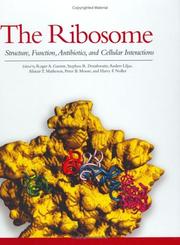| Listing 1 - 10 of 14 | << page >> |
Sort by
|

ISBN: 1555811841 9781555811846 Year: 2000 Publisher: Washington (D.C.): ASM press
Abstract | Keywords | Export | Availability | Bookmark
 Loading...
Loading...Choose an application
- Reference Manager
- EndNote
- RefWorks (Direct export to RefWorks)
Ribosomes --- Ribonucleoprotein particles --- Cell organelles --- Microsomes --- Nucleoproteins --- Protoplasm --- Ribosomes.
Book
ISBN: 0128167343 012816364X 9780128167342 9780128163641 Year: 2021 Publisher: London
Abstract | Keywords | Export | Availability | Bookmark
 Loading...
Loading...Choose an application
- Reference Manager
- EndNote
- RefWorks (Direct export to RefWorks)
Ribosomes. --- Ribonucleoprotein particles --- Cell organelles --- Microsomes --- Nucleoproteins --- Protoplasm
Book
ISBN: 095019722X Year: 1973 Publisher: London Biochemical Society
Abstract | Keywords | Export | Availability | Bookmark
 Loading...
Loading...Choose an application
- Reference Manager
- EndNote
- RefWorks (Direct export to RefWorks)
Histology. Cytology --- Molecular biology --- Ribosomes --- -Ribonucleoprotein particles --- Cell organelles --- Microsomes --- Nucleoproteins --- Protoplasm --- physiology. --- Congresses --- Congresses. --- biochemistry --- physiology --- -physiology. --- Biochemistry --- Physiology --- Ribonucleoprotein particles

ISBN: 0120342367 9786611712716 128171271X 0080582095 9780080582092 Year: 1984 Publisher: Orlando ; London : Academic Press,
Abstract | Keywords | Export | Availability | Bookmark
 Loading...
Loading...Choose an application
- Reference Manager
- EndNote
- RefWorks (Direct export to RefWorks)
ADVANCES IN PROTEIN CHEMISTRY VOL 36
Proteins. --- Ribosomes. --- Ribonucleoprotein particles --- Cell organelles --- Microsomes --- Nucleoproteins --- Protoplasm --- Proteids --- Biomolecules --- Polypeptides --- Proteomics
Book
ISBN: 3036568239 3036568220 Year: 2023 Publisher: Basel : MDPI - Multidisciplinary Digital Publishing Institute,
Abstract | Keywords | Export | Availability | Bookmark
 Loading...
Loading...Choose an application
- Reference Manager
- EndNote
- RefWorks (Direct export to RefWorks)
Ribosome-inactivating proteins (RIPs) are rRNA N-glycosylases isolated mainly from plants that catalyze the hydrolysis of the N-glycosidic bond of a specific adenosine in the sarcin-ricin loop (SRL) of the major ribosomal RNA. Because the SRL is crucial for anchoring translation elongation factors, RIPs cause inactivation of ribosomes. They have been classified into two types based on the presence (type 2 RIPs) or absence (type 1 RIPs) of a lectin chain that can turn type 2 RIPs into potent toxins, such as ricin or abrin. The biological role of these proteins is unknown, but they are thought to be a defense mechanism of some plants against pathogens and predators. Because of their enzymatic action, RIPs show several biological activities, among which antiviral, antifungal and antiproliferative activities stand out. The most promising application of RIPs is their use as a component of immunotoxins, in which RIPs are linked to antibodies that mediate their binding and internalization by malignant cells. In agriculture, RIPs have been shown to increase resistance against viruses, fungi and insects in transgenic plants. The studies collected in this book provide the reader with an overview of the most current and interesting lines of research in the field of RIPs and their applications in medicine and agriculture. Thus, the reprint includes the isolation and biological properties of some new RIPs, both type 1 and type 2, the mechanisms of toxicity of previously described RIPs and two extensive reviews, one on the antiviral activity of RIPs and the other on the strategies used to improve their pharmacological properties.
Ribosomes --- Proteins --- Research --- Synthesis. --- Protein biosynthesis --- Protein synthesis --- Ribonucleoprotein particles --- Cell organelles --- Microsomes --- Nucleoproteins --- Protoplasm --- Metabolism

ISBN: 0387817905 3211817905 3709187443 3709187427 9780387817903 9783211817902 Year: 1985 Volume: 12 Publisher: Wien : Springer-Verlag,
Abstract | Keywords | Export | Availability | Bookmark
 Loading...
Loading...Choose an application
- Reference Manager
- EndNote
- RefWorks (Direct export to RefWorks)
Nucleolus --- 576.311.336 --- Ribosomes. Polyribosomes. Agranular endoplasmic reticulum. --- Nucleolus. --- Ribosomes. --- 576.311.336 Ribosomes. Polyribosomes. Agranular endoplasmic reticulum. --- Ribosomes --- Ribonucleoprotein particles --- Cell organelles --- Microsomes --- Nucleoproteins --- Protoplasm --- Cell nucleolus --- Micronucleus --- Plasmosome --- Cell nuclei --- Ribosomes. Polyribosomes. Agranular endoplasmic reticulum --- REGULATION --- NUCLEOLUS --- MATURATION --- PRERIBOSOMES --- TRANSCRIPTION --- REPLICATION --- GENES --- RIBOSOMAL RNA --- RIBOSOMES --- BIOGENESIS --- PROTEINS --- SENESCENCE --- CARCINOGENESIS --- CELL CYCLE --- STRUCTURES
Book
ISBN: 3642169309 9786613080998 3642169317 1283080990 Year: 2011 Publisher: Berlin : Springer,
Abstract | Keywords | Export | Availability | Bookmark
 Loading...
Loading...Choose an application
- Reference Manager
- EndNote
- RefWorks (Direct export to RefWorks)
This thesis describes research into the mode of function, inhibition, and evolution of the ribosomal catalytic center, the Peptidyl Transferase Center (PTC)--research that has already led to attempts at improving PTC antibiotics. The PhD candidate carried out two parallel studies. One using a combination of X-ray crystallography, biochemistry, molecular biology, and theoretical studies to obtain crystal structures of ribosomal particles with antibiotics that target the PTC, revealing the modes of action, resistance, cross-resistance and discrimination between ribosomes of eubacterial pathogens and eukaryotic hosts. In the second parallel study, the candidate synthesized a ribosomal substructure--one that may represent the minimal entity capable of catalyzing peptide bond formation--shedding light on the origin of the ribosome itself.
Antibiotics -- Biotechnology. --- Ribosomes. --- RNA polymerases. --- Chemistry --- Physical Sciences & Mathematics --- Biochemistry --- Enzymes. --- Biocatalysts --- Ferments --- Soluble ferments --- Ribonucleoprotein particles --- Life sciences. --- Organic chemistry. --- Nucleic acids. --- Proteins. --- Life Sciences. --- Nucleic Acid Chemistry. --- Protein Science. --- Organic Chemistry. --- Catalysts --- Proteins --- Enzymology --- Cell organelles --- Microsomes --- Nucleoproteins --- Protoplasm --- Biochemistry. --- Chemistry, Organic. --- Organic chemistry --- Biological chemistry --- Chemical composition of organisms --- Organisms --- Physiological chemistry --- Biology --- Medical sciences --- Polynucleotides --- Biomolecules --- Composition --- Proteins . --- Proteids --- Polypeptides --- Proteomics
Book
ISBN: 3039211749 3039211730 Year: 2019 Publisher: MDPI - Multidisciplinary Digital Publishing Institute
Abstract | Keywords | Export | Availability | Bookmark
 Loading...
Loading...Choose an application
- Reference Manager
- EndNote
- RefWorks (Direct export to RefWorks)
Sex steroids, including androgens, estrogens, and progestogens, are knownto have widespread physiological actions beyond the reproductive systemvia binding to the sex hormone receptors. Meanwhile, emerging evidence hasindicated that sex hormone receptor signals are involved in the outgrowth ofsome malignancies, such as prostate and breast carcinomas, as well as othersthat have not traditionally been considered as endocrine-related neoplasms. ThisSpecial Issue “Sex Hormone Receptor Signals in Human Malignancies” coversvarious aspects of the potential role of sex hormone receptors and related signalsin prostate cancer, breast cancer, and other neoplastic conditions by depictingpromising findings derived from in vitro and in vivo experiments as well as theanalyses of surgical specimens. The current observations described may thusprovide a unique insight into novel or known functions of sex hormone receptorsand related molecules.
FOXA1 --- COBRA1 --- n/a --- estrogen --- progesterone receptor negative --- mutational profiling --- heterogeneous nuclear ribonucleoprotein K --- estrogen receptor alpha --- salivary gland tumors --- castration-resistant prostate cancer --- ELK1 --- fibroblasts --- androgen receptor --- melanocytes --- drug screening and proteomics --- PI3K pathway --- NELFB --- therapeutic targets --- immunohistochemistry --- androgen deprivation therapy --- ovarian cancer --- estrogen receptor --- epidermal growth factor receptor --- ethinylestradiol --- melanoma --- breast cancer --- keratinocytes --- G-protein coupled estrogen receptor --- prognosis --- levonorgestrel --- ultraviolet radiation --- sex hormone receptors --- upper urinary tract urothelial carcinoma --- CRPC --- nuclear factor erythroid 2-related factor 2 --- TP53
Book
Year: 2021 Publisher: Basel, Switzerland MDPI - Multidisciplinary Digital Publishing Institute
Abstract | Keywords | Export | Availability | Bookmark
 Loading...
Loading...Choose an application
- Reference Manager
- EndNote
- RefWorks (Direct export to RefWorks)
This book is a collection of eight articles, of which seven are reviews and one is a research paper, that together form a Special Issue that describes the roles that long noncoding RNAs (lncRNA) play in gene regulation at a post-transcriptional level.
long non-coding RNA 1 --- RNA binding protein 2 --- post-transcriptional regulation --- long non-coding RNA --- mRNA stability --- RNA binding protein --- microRNA --- gene expression --- long noncoding RNA --- target mimicry --- alternative splicing --- protein re-localization --- translation promotion --- post-translational modification --- double-stranded RNA (dsRNA) --- innate immunity --- repetitive DNA elements (RE) --- antisense transcript --- non-coding RNAs --- long non-coding RNAs --- ncRNAs --- translation --- cancer --- lncRNA --- post-transcription --- RNA-binding --- ribonucleoprotein --- RNAi --- interactome --- prediction --- database --- CLIP --- splicing factors --- miRNAs --- lncRNAs --- ceRNAs --- mTOR pathway --- n/a
Book
ISBN: 3709102146 3709102154 Year: 2011 Publisher: Vienna : Springer,
Abstract | Keywords | Export | Availability | Bookmark
 Loading...
Loading...Choose an application
- Reference Manager
- EndNote
- RefWorks (Direct export to RefWorks)
The ribosome is a macromolecular machine that synthesizes proteins with a high degree of speed and accuracy. Our present understanding of its structure, function and dynamics is the result of six decades of research. This book collects over 40 articles based on the talks presented at the 2010 Ribosome Meeting, held in Orvieto, Italy, covering all facets of the structure and function of the ribosome. New high-resolution crystal structures of functional ribosome complexes and cryo-EM structures of translating ribosomes are presented, while partial reactions of translation are examined in structural and mechanistic detail, featuring translocation as a most dynamic process. Mechanisms of initiation, both in bacterial and eukaryotic systems, translation termination, and novel details of the functions of the respective factors are described. Structure and interactions of the nascent peptide within, and emerging from, the ribosomal peptide exit tunnel are addressed in several articles. Structural and single-molecule studies reveal a picture of the ribosome exhibiting the energy landscape of a processive Brownian machine. The collection provides up-to-date reviews which will serve as a source of essential information for years to come.
Ribosomes -- Congresses. --- Ribosomes -- Structure -- Congresses. --- Ribosomes. --- RNA, Ribosomal. --- Ribosomes --- Proteins --- RNA --- Metabolic Phenomena --- Organelles --- Phenomena and Processes --- Nucleic Acids --- Cytoplasmic Structures --- Amino Acids, Peptides, and Proteins --- Chemicals and Drugs --- Cytoplasm --- Nucleic Acids, Nucleotides, and Nucleosides --- Intracellular Space --- Cellular Structures --- Cells --- Anatomy --- Metabolism --- RNA, Ribosomal --- Ribosomal Proteins --- Human Anatomy & Physiology --- Biology --- Health & Biological Sciences --- Cytology --- Physiology --- Structure --- Ribonucleoprotein particles --- Medicine. --- Gene expression. --- Nucleic acids. --- Biophysics. --- Biological physics. --- Biomedicine. --- Gene Expression. --- Nucleic Acid Chemistry. --- Biophysics and Biological Physics. --- Cell organelles --- Microsomes --- Nucleoproteins --- Protoplasm --- Biological and Medical Physics, Biophysics. --- Polynucleotides --- Biomolecules --- Genes --- Genetic regulation --- Expression --- Biological physics --- Medical sciences --- Physics --- Molecular genetics. --- Biomaterials. --- Molecular Genetics. --- Nucleic Acid. --- Genetics --- Molecular biology
| Listing 1 - 10 of 14 | << page >> |
Sort by
|

 Search
Search Feedback
Feedback About UniCat
About UniCat  Help
Help News
News